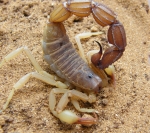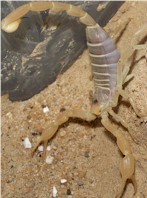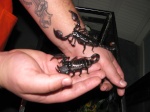| | Androctonus mauritanicus care? |  |
|
|
| Author | Message |
|---|
Crab
Pandinus
Number of posts : 18
Age : 34
Registration date : 2013-01-29
 |  Subject: Androctonus mauritanicus care? Subject: Androctonus mauritanicus care?  2/21/2013, 3:38 pm 2/21/2013, 3:38 pm | |
| Hello, i will be getting 4i A.mauritanicus, and i would like to ask few questions:
Does A.M. like to burrow or they will just sit on sand?
Should i put a water dish?
In scale 1 to 5, how dangerous their venom is?I've read that they are almost same as L.q.
I used search function and google, could really find much info.
Thanks in advance. | |
|
  | |
shadowfoot
Parabuthus

Number of posts : 1296
Age : 32
Location : South Africa
Registration date : 2012-01-18
 |  Subject: Re: Androctonus mauritanicus care? Subject: Re: Androctonus mauritanicus care?  2/21/2013, 4:04 pm 2/21/2013, 4:04 pm | |
| Mine love to burrow so keep them on a nice and deep substrate. You can mist a small portion of the enclosure wall once every week or so, you can start offering standing water when they reach about 6i. Mine have a serious aggression problems and will sting at any movement near them and their venom is up there with L.quinquestriatus but they are much faster and more aggressive so keep your tweezers nearby  | |
|
  | |
Den
Babycurus

Number of posts : 290
Age : 51
Registration date : 2011-10-27
 |  Subject: Re: Androctonus mauritanicus care? Subject: Re: Androctonus mauritanicus care?  2/21/2013, 4:23 pm 2/21/2013, 4:23 pm | |
| Hi Crab .. Androctonus-mauritanicus like many of the androctonus species are semi fossorial and will usually burrow if given the opportunity although many people are not generally aware of this and as such do keep them on loose sand. whether you decide to allow your scorps to burrow or not though will almost certainly have no ill effects on their well being. It depends how much of a purist you are. If you want to set up an enclosure that mimics their natural habitat then you really need to include at least an area of consolidated sand. Maybe an enclosure set uo where half the groundplan is plain sand with the other half being consolidated sand shaped in the form of a mound or other not flat shape..A few tufts of dried grass pushed into the sand while damp and stones placed on the plain sand section would create an interesting and pleasing to the eye enclosure. As for a water dish i would advise using a small bottle cap which could be filled and then left to evaporate over a period, refilling it again after it had been dry for maybe a week...ensure though that the enclosure has good ventilation so that humidity doesn't get a chance to accumulate....I would advise against spraying simply because your temps really need to be up in the low 30'sC day down to 20-24C night and at these temps small droplets of water from spraying evaporate very quickly not really giving your scorps the ability to drink from them. Asking about venom on a scale of 1 to 5 doesn't really make a lot of sense for me...whether it's 3.5, 4 or 5 is quite irrelevant...You don't want to be stung by them regardless. That said, these scorpions are medically significant with an LD factor slightly higher than L. quinquestriatus. There isn't a comprehensive index of all scorpions LD50 values but it's assumed that most androctonus species are quite venomous and as i mentioned before you don't want to be stung by them regardless. It will hurt a lot and could potentially put you in hospital .. and if you're a person of slight build with not to many kilo's hanging from your shoulders it could potentially kill you before you managed to get to a hospital. So, treat any venomous creature with respect...don't pick it up, don't tease it and adhere to safe procedures. Scorpions can't climb glass or smooth plastic so already there you have a tremendous tool for keeping yourself safe. Don't pick it up and don't be tempted to use tongs to do it unless you know exactly what you are doing..To move scorpions i find the best way is simply to usher it into a small container with a chop stick or similar and put the lid on. You're then free to move it wherever you want...There's absolutely no need for any kind of physical contact.......Chuckles.......Sorry if i've rambled on a bit about stuff you didn't even ask about but i just thought i'd use the opportunity to give you a simple way of ensuring both yourself and your scorps safety. Peace..  Edit .. sorry Shadowfoot .. you got your reply in while i was tying this....  | |
|
  | |
Crab
Pandinus
Number of posts : 18
Age : 34
Registration date : 2013-01-29
 |  Subject: Re: Androctonus mauritanicus care? Subject: Re: Androctonus mauritanicus care?  2/21/2013, 4:33 pm 2/21/2013, 4:33 pm | |
| Thanks guys for fast and very informative answers.
I'll probably try to make something like their natural habitat.
And if i want it to burrow, should i mix sand with vermaculite or something like that?
The question about venom was just out of curiosity, i know that they are highly venomous
Of course, i will not touch it with my hands
Basically, where i live, none of the hospitals have antivenom for anything. | |
|
  | |
Den
Babycurus

Number of posts : 290
Age : 51
Registration date : 2011-10-27
 |  Subject: Re: Androctonus mauritanicus care? Subject: Re: Androctonus mauritanicus care?  2/21/2013, 4:48 pm 2/21/2013, 4:48 pm | |
| - Crab wrote:
- Thanks guys for fast and very informative answers.
And if i want it to burrow, should i mix sand with vermaculite or something like that?
No no .. vermiculite won't hold the sand together. What you want is clay based sand that when dampened and allowed to dry hardens, allowing scorps to burrow in it and for those burrows to retain their integrity. Most pet stores sell this kind of sand, usually in the reptile section although that can sometimes be quite expensive...sometimes you can find sand naturally in nature that has this property...If you know of anywhere where you live that has sand that after becoming wet becomes hard then you can use that....Alternatively you can make your own using standard sand (some call it play sand) and clay (usually brought from florists or modelling shops)....just dissolve the wet sticky clay in hot water (i use a ball of clay around the size of a medium apple to 5 liters of water) and then use that water to dampen your sand thoroughly...not wringing wet but damp....when dry the sand will be hard enough for your scorp to burrow in it without the sand falling apart. You can also roll the damp clay out into thin sheets and allow that to dry. Once dry crumble it with your fingers into a fine powder and mix it with sand....Dampen and you get the same effect...Consolidated sand..  | |
|
  | |
emperor5
Tityus

Number of posts : 516
Age : 35
Registration date : 2012-06-09
 |  Subject: Re: Androctonus mauritanicus care? Subject: Re: Androctonus mauritanicus care?  2/21/2013, 4:49 pm 2/21/2013, 4:49 pm | |
| if u do wait untill the substrate drys out completly before puting the scorpion in | |
|
  | |
Crab
Pandinus
Number of posts : 18
Age : 34
Registration date : 2013-01-29
 |  Subject: Re: Androctonus mauritanicus care? Subject: Re: Androctonus mauritanicus care?  2/22/2013, 10:27 am 2/22/2013, 10:27 am | |
| Thanks.
One more question.
I've read that substrate should be dark so it can camouflage. So should i get dark sand/mix yellow sand with something, or yellow sand will be fine? | |
|
  | |
Den
Babycurus

Number of posts : 290
Age : 51
Registration date : 2011-10-27
 |  Subject: Re: Androctonus mauritanicus care? Subject: Re: Androctonus mauritanicus care?  2/22/2013, 10:53 am 2/22/2013, 10:53 am | |
| I've not heard this mentioned before and quite honestly i don't think it will make any difference for your scorps well being one way or the other. A. mauritanicus comes from Morocco and Mauritania and these countries are predominantly desert countries with orange/yellow sand.
Besides, scorps rarely lay out in the open during daylight so the camouflage thought doesn't really make much sense to me. If you like the idea of using a dark substrate go for it although it might just end up looking like plain dirt. A lighter substrate will probably look more pleasing to the eye and give a greater contrast when your scorp is out on display. So use whichever you feel fits your style. It won't affect your scorps natural behavior.
| |
|
  | |
Sponsored content
 |  Subject: Re: Androctonus mauritanicus care? Subject: Re: Androctonus mauritanicus care?  | |
| |
|
  | |
| | Androctonus mauritanicus care? |  |
|

